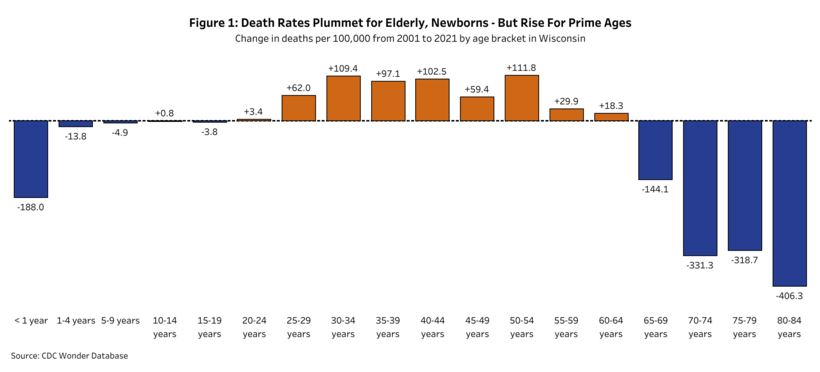State’s Younger Adults Dying at Higher Rates
Mortality rate up 137% for those aged 30-34 since 2001, while the rate declined for seniors.

An empty room in the ICU on Wednesday, Jan. 5, 2022, at Meriter Hospital in Madison, Wis. Angela Major/WPR
Over the last two decades, death rates for young and middle-aged adults in Wisconsin have skyrocketed. Meanwhile, older people in the state are dying at lower rates than ever before.
It’s a tale of divergent trends, according to the Wisconsin Policy Forum‘s Mark Sommerhauser. The nonpartisan policy research organization released a new report Friday looking at statewide mortality rates from 2001 to 2021.
“Unfortunately, what we have on the other side of the coin here is that we’ve seen a pretty significant increase in mortality among younger adults. And … the single biggest cause really is drug overdoses,” he continued.
The report looked at mortality data from the Centers for Disease Control and Prevention including cause of death for different age and racial groups.
For Wisconsinites ages 30-34, the mortality rate rose 137 percent from 2001 to 2021.
Deaths from COVID-19 played a significant role in that spike — but Sommerhauser said it’s important to note that these age groups typically have lower death rates than their older counterparts.
“One thing to remember is that total mortality for all causes among young adults is quite low,” he said. “So any sort of increase among younger adults is going to move the needle among total mortality for young adults more (than older adults), because there are just fewer deaths.”
For younger adults in the state, the report found the overarching reason for higher death rates is drug overdose. Over the last two decades, overdose deaths made up more than half of the mortality increase for Wisconsinites ages 20-49.
In 2021 alone, there were 1,427 opioid overdose deaths in Wisconsin, according to data from the state Department of Health Services, up from 1,227 opioid-related deaths in 2020.
In September 2022, DHS put out a public health advisory saying fentanyl was increasingly behind overdose deaths in Wisconsin. And the state is expected to see millions of dollars in federal funding and settlements with pharmaceutical companies to address the opioid crisis.
The Policy Forum report also noted stark disparities in death rates for Black Wisconsinites, particularly from homicide.
In 2021, the homicide mortality rate per 100,000 Black people in Wisconsin was 57.4 — considerably higher than the national rate of 34.
Black people in Wisconsin were nearly 32 times more likely to die from homicide in 2021 than white people. And that rate has increased dramatically over time. In 2001, a Black person in Wisconsin was nearly 15 times more likely to die from homicide than a white person.
“It’s almost hard to conceptualize how big of a disparity we’re talking about,” Sommerhauser said. “This is not new, racial disparities and homicide is not something that’s only happening in Wisconsin — but our racial disparities here are significantly worse than national.”
Despite the report’s stark findings, Sommerhauser said it’s important not to lose sight of some of the encouraging trends in Wisconsin’s death rates.
From 2001 to 2021, rates of deaths from stroke decreased 45.4 percent among all Wisconsinites. Heart disease deaths declined by 26.7 percent and cancer-related deaths went down by 24.4 percent.
Infant mortality also made noticeable declines — although racial disparities persist in Wisconsin for people of color.
As for what’s next, Sommerhauser said he — and those at the Wisconsin Policy Forum — hope lawmakers use these findings to help shape policy going forward.
“The drug overdose crisis that we have in our state, in our country, needs to be a high priority for policymakers,” he said.
Given an unprecedented state budget surplus, Sommerhauser said the resources are there: “The hard part is going to be figuring out where to direct those resources in a way that’s really going to hopefully have an impact on reducing overdose deaths.”
Divergent trends: Young adults in Wisconsin dying at higher rates, while older adults are living longer was originally published by Wisconsin Public Radio
UPDATE: An earlier version of this article referred to the homicide rate as a percentage. It is a figure per 100,000 people.























Did CDC provide a year-by-year breakdown, or just the twenty-year summary?
What’s important right now is knowing what happened from mid-2020 to date.
That’s where the vaccine-related injury and death numbers will be.